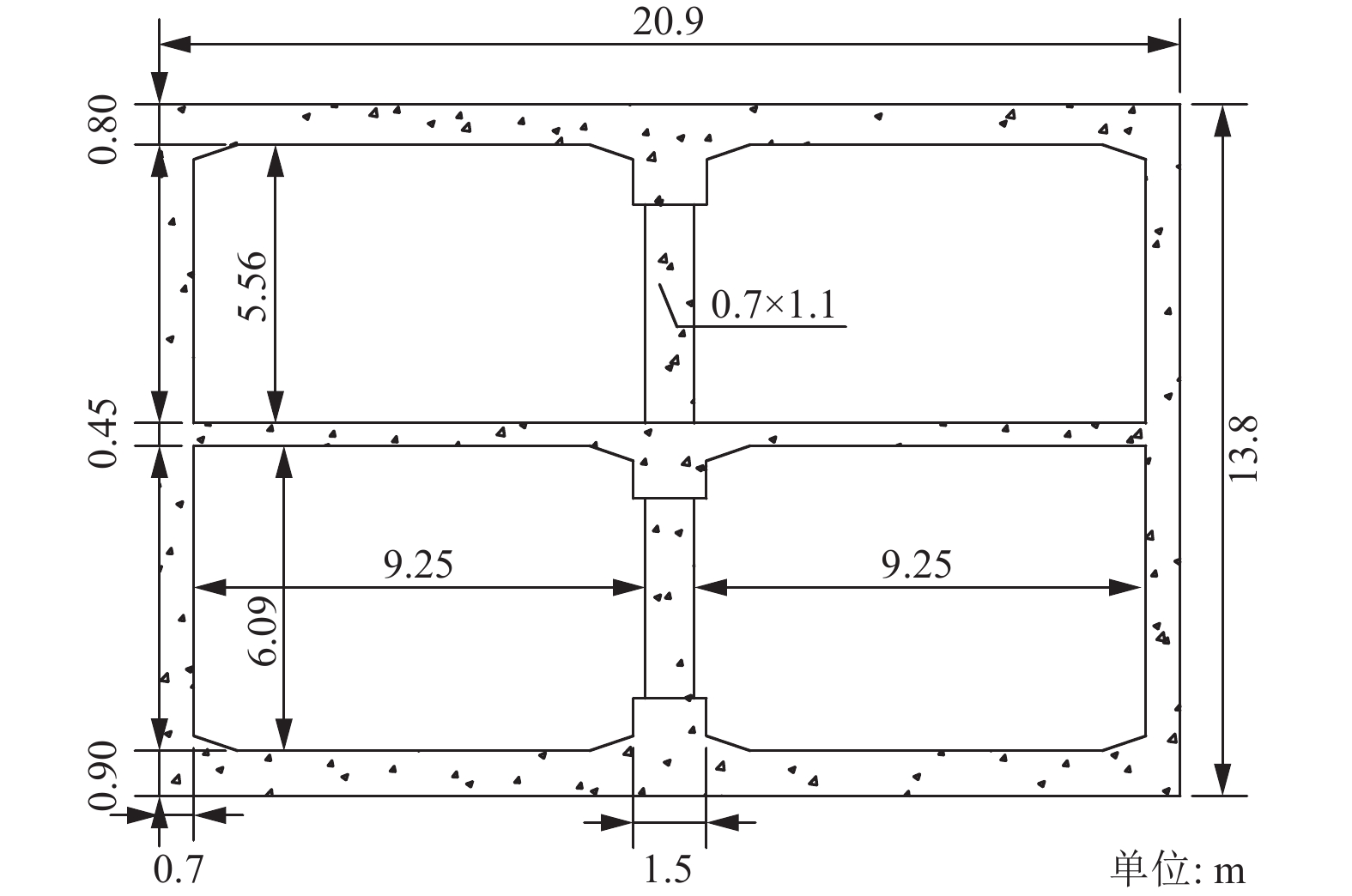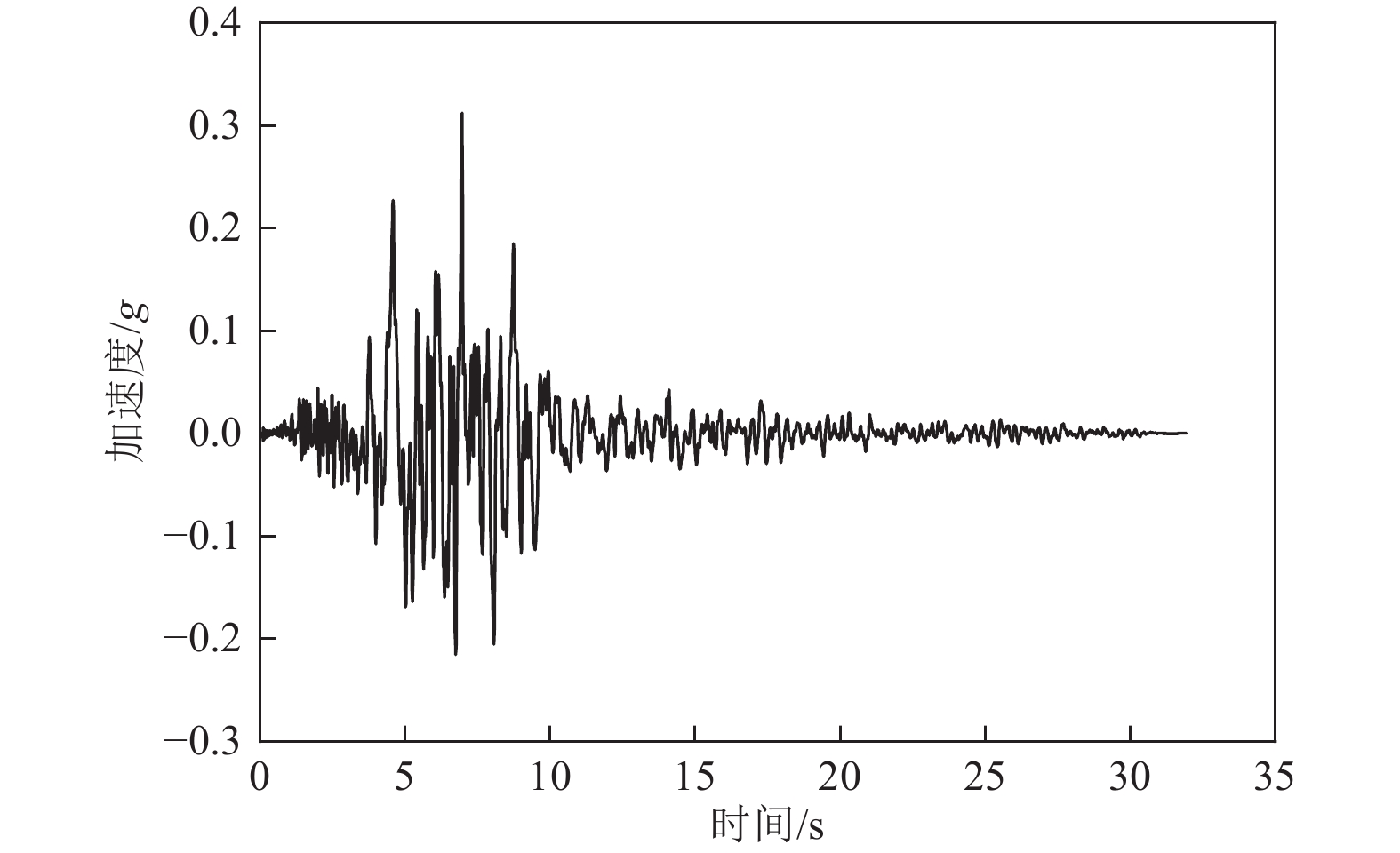Pushover Method Based Seismic Analysis for Subway Station Built in the Floodplain Soft Soil Area
-
摘要: 为研究地下结构Pushover分析方法在不同条件下的适用性,基于有限元软件平台,建立长江漫滩区地铁车站土-结构二维有限元分析模型,分别采用非线性动力时程分析方法与地下结构Pushover分析方法对5种不同土体刚度模型进行抗震分析。峰值层间位移角与峰值内力的分析结果表明,当土体刚度与结构刚度一致时,地下结构Pushover分析方法计算结果与非线性动力时程分析方法计算结果相近,而当土体刚度小于结构刚度或土体刚度大于结构刚度时,Pushover分析方法计算精度下降。
-
关键词:
- 地下结构 /
- Pushover分析方法 /
- 土体刚度 /
- 抗震分析 /
- 长江漫滩区
Abstract: This paper is to study the applicability of the underground structure pushover analysis method under different conditions. Based on the finite element software platform, the soil-structure two-dimensional finite element analysis model based on the cross section of the subway station located in Yangtze River floodplain aera was established. The nonlinear dynamic time history analysis method and the pushover analysis method are respectively used for seismic analysis of five models with different soil stiffness. The analysis results based on the peak inter-layer displacement angle and the peak internal force show that, when the soil stiffness is consistent with the structural stiffness, the calculation results of the pushover analysis method are very close to the results of the nonlinear dynamic time history analysis method. However, when the soil stiffness is less than the structural stiffness or when the soil stiffness is greater than the structural stiffness, the calculation accuracy of the pushover analysis method will decrease significantly. -
表 1 地铁车站土层物理参数
Table 1. The soil parameters of subway station
编号 土体 深度/m 密度/(kg·m−3) 剪切波速/(m·s−1) 泊松比 1 回填土 2 1 700 147 0.35 2 粉质黏土 6 2 020 190 0.35 3 黏土 7 2 000 193 0.36 4 粉细砂 2 2 050 274 0.33 5 黏土 10 2 020 300 0.36 6 粉细砂 3 2 050 328 0.33 7 黏土 2 1 990 331 0.36 8 细砂 6 2 050 368 0.33 9 粉质黏土 7 2 000 382 0.35 10 花岗岩 — 2 500 700 0.25 表 2 计算结果
Table 2. Summary of calculation results
工况
编号土-结构
刚度比层间位移角/mm 轴力/(kN·m−1) 剪力/(kN·m−1) 弯矩/[(kN·m)m−1] 动力时程分析 Pushover分析 动力时程分析 Pushover分析 动力时程分析 Pushover分析 动力时程分析 Pushover分析 A 0.25 1.69 1.580 1 311 1 295 111 110 412 415 B 0.36 1.47 1.500 1 309 1 280 113 112 414 416 C 1.00 0.89 0.895 1 269 1 249 104 104 372 369 D 1.40 0.57 0.490 1 183 1 167 78 69 270 238 F 2.00 0.38 0.340 1 142 1 140 59 54 201 182 表 3 计算误差
Table 3. Computed error
工况编号 土-结构刚度比 层间位移角误差/% 轴力误差/% 剪力误差/% 弯矩误差/% A 0.25 −6.51 −1.22 −4.5 1.46 B 0.36 2.04 −2.22 −4.42 2.9 C 1.00 0.56 −1.58 0.96 −0.81 D 1.40 −14.04 −1.35 −11.54 −11.85 F 2.00 −10.53 −0.18 −8.47 −9.45 -
还毅, 方秦, 柳锦春等, 2011. 考虑时空耦联的等效惯性加速度加载的地下结构pushover分析. 地震工程与工程振动, 31(4): 64—70Huan Y. , Fang Q. , Liu J. C. , et al. , 2011. Pushover analysis of underground structures by the time-space coupled equivalent inertial acceleration. Journal of Earthquake Engineering and Engineering Vibration, 31(4): 64—70. (in Chinese) 刘晶波, 刘祥庆, 李彬, 2008. 地下结构抗震分析与设计的Pushover分析方法. 土木工程学报, 41(4): 73—80Liu J. B. , Liu X. Q. , Li B. , 2008. A pushover analysis method for seismic analysis and design of underground structures. China Civil Engineering Journal, 41(4): 73—80. (in Chinese) 刘晶波, 刘祥庆, 薛颖亮, 2009. 地下结构抗震分析与设计的Pushover方法适用性研究. 工程力学, 26(1): 49—57Liu J. B. , Liu X. Q. , Xue Y. L. , 2009. Study on applicability of a pushover analysis method for seismic analysis and design of underground structures. Engineering Mechanics, 26(1): 49—57. (in Chinese) 彭有宝, 王鑫, 2017. 轨道交通地下结构抗震设计相关反应加速度法分析. 地震工程学报, 39(6): 1037—1045Peng Y. B. , Wang X. , 2017. Analysis of the response acceleration method related to the seismic design of underground rail transit structures. China Earthquake Engineering Journal, 39(6): 1037—1045. (in Chinese) 曲哲, 叶列平, 2011. 基于有效累积滞回耗能的钢筋混凝土构件承载力退化模型. 工程力学, 28(6): 45—51Qu Z. , Ye L. P. , 2010. Strength deterioration model based on effective hysteretic energy dissipation for RC members under cyclic loading. Engineering Mechanics, 28(6): 45—51. (in Chinese) 许成顺, 许紫刚, 杜修力等, 2017. 地下结构抗震简化分析方法比较研究. 地震工程与工程振动, 37(2): 65—80Xu C. S. , Xu Z. G. , Du X. L. , et al. , 2017. Comparative study of simplified methods for seismic analysis of underground structure. Earthquake Engineering and Engineering Vibration, 37(2): 65—80. (in Chinese) 禹海涛, 袁勇, 张中杰等, 2011. 反应位移法在复杂地下结构抗震中的应用. 地下空间与工程学报, 7(5): 857—862Yu H. T. , Yuan Y. , Zhang Z. J. , et al. , 2011. Application of response displacement method on seismic design of a complex underground structure. Chinese Journal of Underground Space and Engineering, 7(5): 857—862. (in Chinese) Hleibieh J. , Wegener D. , Herle I. , 2014. Numerical simulation of a tunnel surrounded by sand under earthquake using a hypoplastic model. Acta Geotechnica, 9(4): 631—640. doi: 10.1007/s11440-013-0294-8 Iida H. , Hiroto T. , Yoshida N. , et al. , 1996. Damage to Daikai subway station. Soils and Foundations, 36(Special): 283—300. doi: 10.3208/sandf.36.Special_283 Jiang J. W. , Xu C. S. , El Naggar H. M. , et al. , 2021. Improved pushover method for seismic analysis of shallow buried underground rectangular frame structure. Soil Dynamics and Earthquake Engineering, 140: 106363. doi: 10.1016/j.soildyn.2020.106363 Ma C. , Lu D. C. , Du X. L. , et al. , 2019. Structural components functionalities and failure mechanism of rectangular underground structures during earthquakes. Soil Dynamics and Earthquake Engineering, 119: 265—280. doi: 10.1016/j.soildyn.2019.01.017 Newmark N. M., 1968. Problems in wave propagation in soil and rock. In: Proceedings of International Symposium on Wave Propagation and Dynamic Properties of Earth Materials. Albuquerque: University of New Mexico Press, 7—26. Penzien J. , 2000. Seismically induced racking of tunnel linings. Earthquake Engineering & Structural Dynamics, 29(5): 683—691. Tsinidis G. , Pitilakis K. , Trikalioti A. D. , 2014. Numerical simulation of round robin numerical test on tunnels using a simplified kinematic hardening model. Acta Geotechnica, 9(4): 641—659. doi: 10.1007/s11440-013-0293-9 Xu Z. G. , Du X. L. , Xu C. S. , et al. , 2019. Numerical research on seismic response characteristics of shallow buried rectangular underground structure. Soil Dynamics and Earthquake Engineering, 116: 242—252. doi: 10.1016/j.soildyn.2018.10.030 -




 下载:
下载:




